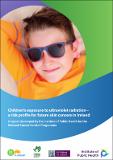| dc.contributor.author | McAvoy, H. | |
| dc.contributor.author | Rodriguez, Leonor | |
| dc.contributor.author | Költő, András | |
| dc.contributor.author | Nic Gabhainn, Saoirse | |
| dc.date.accessioned | 2020-06-18T10:19:31Z | |
| dc.date.available | 2020-06-18T10:19:31Z | |
| dc.date.issued | 2020-06 | |
| dc.identifier.citation | McAvoy, H, Rodriguez, L, Költő, A and NicGabhainn, S. (2020) Children’s exposures to ultraviolet radiation - a risk profile for future skin cancers in Ireland. Institute of Public Health in Ireland. | en_IE |
| dc.identifier.isbn | 978-0-9570083-9-7 | |
| dc.identifier.uri | http://hdl.handle.net/10379/16034 | |
| dc.description.abstract | Key points
Why has this report been developed?
Excessive exposure to ultraviolet (UV) radiation, sunburn and sunbed use in childhood
are risk factors for developing skin cancer in adult life. This report presents data on these
risk factors in Ireland for the first time. Data are presented principally from the Irish
Health Behaviour in School-aged Children (HBSC) Study 2018 (1). This report was developed
to support implementation and monitoring of the Government’s National Skin Cancer
Prevention Plan 2019-2022 (2).
What do we know about sunburn and sun protective behaviours in childhood?
Levels of self-reported childhood sunburn in Ireland were high. Nine out of 10
schoolchildren aged 10 to 17 reported at least one experience of sunburn. Around three
quarters reported sunburn within the last year. Children from more affluent families were
more likely to report experiencing sunburn.
Eight out of 10 schoolchildren reported wearing sunscreen and seven out of 10 reported
using sunglasses on sunny days. Adoption of other sun protection measures, like covering
up, wearing hats and avoiding peak UV hours, were less consistent. One in three children
reported that they avoided peak UV hours and half reported wearing protective clothing to
cover arms and legs when in the sun. Overall, girls were more likely to adopt sun protection
behaviours but the patterns differed by gender with girls more likely to wear sunscreen,
sunglasses, clothes that cover arms and legs as well as avoid peak UV hours. Boys were
more likely to wear hats.
What do we know about skin type and children’s attitudes to tanning?
Survey data from schoolchildren in Northern Ireland shows that 58% of children find tans
appealing. However, 69% of children were unable to correctly identify risks associated with
tanning. Most teens in Ireland identify as Fitzpatrick skin type I or II1 indicating a significant
population level genetic predisposition to future skin cancer (3). We could not source any
reliable data on the use of fake tan or tanning accelerator type products.
What did children say about sunbed use?
Sunbed use was rare, as reported by 3% of children. The provision of sunbed services to
children (aged under 18) is contrary to Irish law as outlined in the Public Health (Sunbeds) Act
2014.
How might our weather be affecting risk?
Six of the 10 warmest years in Ireland’s history have occurred during the childhoods of the
current cohort of 18 to 20-year olds. Since 2006, for the period May to September, around
two thirds of days recorded a UV index of 3 or more. During school summer holidays, June
to August, around three quarters of days recorded a UV index of 3 or more. A UV index of
3 of more results in greater risk for skin damage and it is strongly advised to protect the
skin. When the UV Index is over 3 the WHO recommends practicing multiple sun protection
behaviors including seeking shade during midday hours, wearing on a shirt, putting on
sunscreen and a hat.
Climate research predicts hotter summers and more heatwaves. This may present
elevating risk for UV skin damage, particularly in terms of childhood exposure during the
summer school holidays. The relationship between climate change and skin damage is
poorly understood.
What are the priority issues for data and research?
Data presented in this report could have the potential to inform the development of
indicators, policy monitoring and inform risk modelling studies.
The main data and research gaps identified include a lack of data on children under
10 years old and on sunburn severity, specifics on the types of sunscreens, hats and
sunglasses being used, factors influencing children’s risk behaviours, and the retail and
marketing of commercial sunbed use to young people in Ireland. | en_IE |
| dc.format | application/pdf | en_IE |
| dc.language.iso | en | en_IE |
| dc.publisher | Institute of Public Health in Ireland | en_IE |
| dc.rights | Attribution-NonCommercial-NoDerivs 3.0 Ireland | |
| dc.rights.uri | https://creativecommons.org/licenses/by-nc-nd/3.0/ie/ | |
| dc.subject | Children | en_IE |
| dc.subject | exposure | en_IE |
| dc.subject | ultraviolet radiation | en_IE |
| dc.subject | risk profile | en_IE |
| dc.subject | skin cancer | en_IE |
| dc.subject | National Cancer Control Programme | en_IE |
| dc.title | Children's exposure to ultraviolet radiation - a risk profile for future skin cancers in Ireland | en_IE |
| dc.type | Report | en_IE |
| dc.date.updated | 2020-06-18T09:05:18Z | |
| dc.identifier.doi | 10.14655/11971-1084881 | |
| dc.local.publishedsource | https://publichealth.ie/wp-content/uploads/2020/06/20200616-Childrens-exposure-to-UV-report-final.pdf | en_IE |
| dc.description.peer-reviewed | peer-reviewed | |
| dc.internal.rssid | 21492458 | |
| dc.local.contact | Andras Kolto, -. - Email: andras.kolto@nuigalway.ie | |
| dc.local.copyrightchecked | Yes | |
| dc.local.version | PUBLISHED | |
| nui.item.downloads | 106 | |


